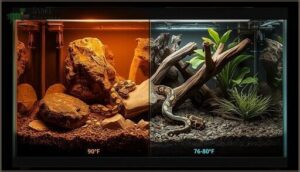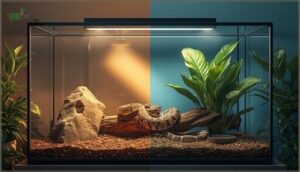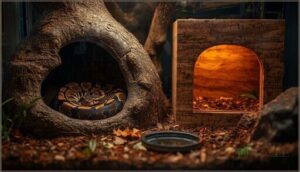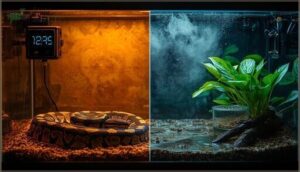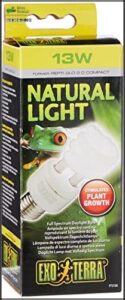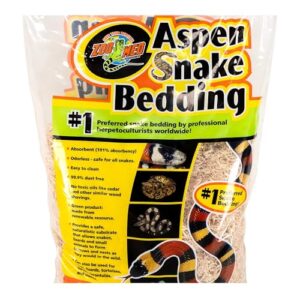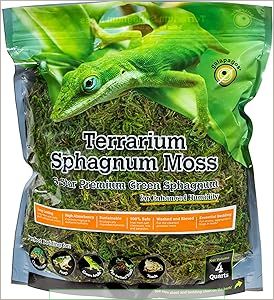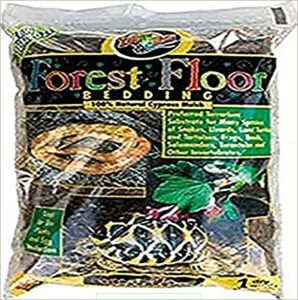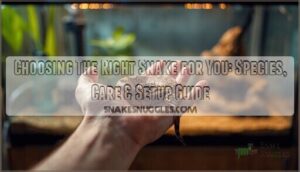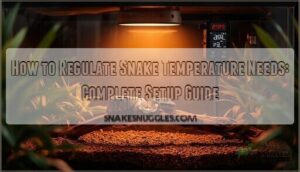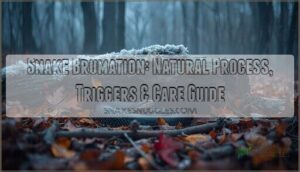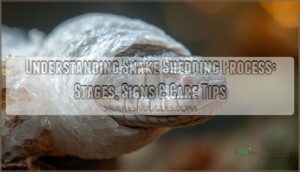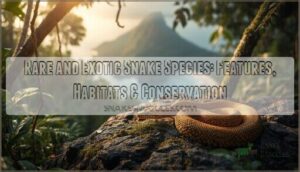This site is supported by our readers. We may earn a commission, at no cost to you, if you purchase through links.
Your ball python will spend its entire life inside the enclosure you create, making your setup decisions far more critical than most new keepers realize. A cramped 20-gallon tank might seem adequate at the pet store, but it sets the stage for chronic stress, feeding problems, and even respiratory infections down the line.
The right terrarium environment doesn’t just house your snake—it actively encourages natural behaviors like thermoregulation, secure hiding, and healthy shedding cycles. Getting the basics right from day one means fewer health complications and a python that actually thrives rather than merely survives.
This complete care guide walks you through proven terrarium specifications that work.
Table Of Contents
- Key Takeaways
- Choosing The Ideal Ball Python Enclosure
- Essential Components for Terrarium Setup
- Selecting The Best Substrate and Décor
- Maintaining Optimal Temperature and Humidity
- Top 7 Products for Ball Python Terrariums
- Frequently Asked Questions (FAQs)
- How do I set up a ball python terrarium?
- Can a ball python live in a 40 gallon terrarium?
- How do I set up a habitat for a ball python?
- What kind of terrarium do ball pythons need?
- How do you make a terrarium look like a ball python?
- Do ball python terrariums need a hideout?
- How Often Should I Clean My Ball Python’s Enclosure?
- What is the Best Way to Feed My Ball Python?
- How Often Should I Handle My Ball Python?
- What Plants Are Safe to Have in a Ball Python Enclosure?
- Conclusion
Key Takeaways
- Ball pythons require enclosures sized to their age and sex—hatchlings thrive in 10-gallon spaces until 17 inches, juveniles need 40 gallons, adult males need a minimum of 60 gallons (4’x2′ floor), and females demand 100-gallon homes due to their larger size.
- Proper thermal gradients with a 90-95°F basking spot and 75-80°F cool zone, combined with 55-65% baseline humidity (rising to 70-75% during shedding), prevent respiratory infections and shedding complications that plague improperly maintained enclosures.
- PVC enclosures outperform other materials by retaining heat efficiently, resisting mold without sealing, and simplifying cleaning, while front-opening designs reduce snake stress compared to top-opening alternatives that trigger defensive responses.
- Essential setup components include at least two hide boxes (one warm, one cool), moisture-retaining substrates like coconut fiber or cypress mulch instead of mold-prone aspen, and climbing branches that 87% of ball pythons will actively use when provided.
Choosing The Ideal Ball Python Enclosure
Your ball python’s enclosure is more than just a container—it’s their entire world. Getting the size, materials, and design right from the start will keep your snake healthy and reduce stress for both of you.
Your ball python’s enclosure isn’t just a container—it’s their entire world, and getting the size, materials, and design right from the start keeps your snake healthy and stress-free
Let’s break down what you need to think about when choosing the perfect home for your python.
Minimum Enclosure Size by Age and Sex
Your ball python’s enclosure size directly impacts its health and stress levels. Hatchlings thrive in compact 10-gallon spaces until reaching 17 inches, while juveniles need 40-gallon setups. Adult males require minimum 60-gallon enclosures with 4’x2′ floor space, but females demand larger 100-gallon homes due to their greater size.
Proper ball python terrarium setup means matching enclosure dimensions to your snake’s age and sex. To guarantee a suitable environment, consider the importance of a proper temperature gradient.
Recommended Enclosure Materials (Wood, PVC, Plastic)
Once you’ve settled on the right size, you’ll need to choose enclosure materials that balance thermal insulation, moisture control, and durability.
PVC enclosures offer the best all-around performance—they retain heat efficiently, resist mold without sealing, and simplify cleaning. Wood enclosures provide excellent insulation but demand waterproof treatment to prevent warping. Plastic tubs work well for juveniles due to affordability and moisture resistance, though they lack the aesthetic options of premium materials.
For custom builds, melamine cages resist moisture and are easily cleaned.
Ventilation and Security Considerations
After choosing your material, you’ll face a balancing act—your ball python needs enough airflow to prevent respiratory infections but not so much ventilation that humidity plummets. These escape artists demand secure enclosures with locked mechanisms, not just mesh tops.
Your ventilation design should include:
- Small vent holes positioned for cross-flow without creating drafts
- Humidity levels maintained between 65% and 85% through restricted airflow
- Mechanical locks on all openings to prevent determined escapes
Front-Opening Vs. Top-Opening Designs
Once you’ve nailed ventilation, the door style matters more than you’d think. Front-opening enclosures let you reach in without looming overhead—reducing snake stress and making feeding easier. Top-opening designs offer tighter security but require moving fixtures every time you access your ball python terrarium setup.
| Feature | Front-Opening | Top-Opening |
|---|---|---|
| Access Convenience | Easy daily maintenance | Requires moving lights |
| Snake Stress Response | Less defensive posture | May trigger flight response |
| Enclosure Security | Needs quality latches | Naturally more secure |
Design trends favor front-opening PVC enclosures for their thermal stability and customization potential.
Opaque Sides and Snake Stress Reduction
Beyond ventilation, visual exposure plays a surprising role in your ball python’s comfort. Opaque sides create essential visual barriers that mimic natural burrows, triggering calmer snake behavior and reducing stress-induced hiding.
Consider these benefits of opaque walls in your reptile enclosure:
- Fewer defensive reactions to movement outside the tank
- Increased use of hiding places throughout the habitat
- Better feeding response rates
- More natural resting behaviors inside hides
PVC enclosures naturally provide this environmental enrichment.
Essential Components for Terrarium Setup
Once you’ve chosen the right enclosure, it’s time to set up the interior to support your ball python’s health and comfort. The key is creating a controlled environment that mimics their natural habitat—complete with proper temperature zones, humidity levels, and hiding spots.
Let’s break down each essential component you’ll need to get your terrarium right.
Creating Thermal Gradients and Hot Spots
Your ball python can’t regulate its body temperature on its own, so you’ll need to create a thermal gradient with distinct temperature zones.
Set up heat sources to establish a hot spot reaching 90°F on one end while keeping the cooler side around 76-80°F.
This temperature gradient lets your snake move between zones for proper thermoregulation throughout the day.
Humidity Control and Measurement
To keep your snake healthy, you’ll need to maintain humidity levels between 55–65% daily, rising to 80% during shedding. Monitor moisture levels with a digital hygrometer placed centrally in the enclosure—calibrate it for accuracy.
Boost humidity by:
- Misting substrate directly in the evening
- Placing water bowls over heat sources to increase evaporation rates
- Adding a humid hide with moisture-retentive material
- Using humidity sensors to track changes
- Adjusting ventilation in drier climates
Lighting Needs and UVB Benefits
Did you know ball pythons can see UV light, even though they’re mostly nocturnal? UVB lighting isn’t just about survival—it helps regulate circadian rhythms and boosts bone health. Use a full-spectrum fluorescent or a UVB lamp for a balanced lighting cycle. Aim for moderate UVB intensity, covering half the enclosure.
| Lighting Type | UVB Intensity |
|---|---|
| T5 HO UVB Lamp | 5–7% |
| Fullspectrum Fluorescent | Optional |
| UVB rays | Moderate |
| Lighting Cycles | 12/12 hr |
| UVB Lamp Placement | Warm side |
Selecting and Placing Hide Boxes
Your ball python needs at least two hides—one on the warm side, one on the cool side—for proper thermoregulation needs. Choose non-toxic materials like plastic, wood, or cork bark that guarantee hide material safety.
The hide box should be snug, just big enough for your snake to curl up comfortably. This size vs. security balance reduces stress and provides effective shedding aid while supporting enrichment strategies.
Adding Climbing Branches and Visual Barriers
You might be surprised that 87% of ball pythons climb when branches are offered. Adding sturdy climbing branches with proper branch safety measures creates enrichment benefits through natural behaviors and climbing opportunities.
Visual obstruction from artificial foliage or décor provides stress reduction by establishing habitat complexity. These enrichment features work together—the climbing branch encourages activity while visual barriers create security, supporting overall well-being.
Selecting The Best Substrate and Décor
The floor of your ball python’s enclosure does more than just look nice—it directly affects humidity, cleanliness, and your snake’s comfort. You’ll need to choose a substrate that holds moisture without becoming a breeding ground for mold, while also considering safety and ease of maintenance.
Let’s walk through your best options and how to set up a terrarium that keeps your python healthy and stress-free.
Substrate Options: Coconut, Aspen, Bark, Paper
Your substrate options shape your python’s comfort and health. Coconut fiber excels at humidity control and mimics natural burrowing environments, while bark chips offer moderate moisture retention with less dust.
Paper towels work best for quarantine situations—they’re easy to monitor and eliminate ingestion risks.
Aspen shavings aren’t recommended because they mold quickly at the 70-80% humidity your ball python needs during shedding.
Moisture Retention and Mold Resistance
You’ll want at least four inches of moisture-retaining substrate like coconut coir or peat moss to maintain stable humidity levels between 50% and 60%. Change your substrate every four to five weeks to prevent mold buildup—damp sphagnum moss in humid hides needs replacement more frequently.
PVC enclosures resist mold better than wood, which absorbs moisture and can rot without proper sealing.
Safe and Unsafe Substrate Choices
Choosing the right substrate is essential for keeping your ball python healthy and maintaining a mold-free enclosure. Coconut fiber, such as Zoo Med Eco Earth, is highly recommended for its humidity control and safety, as it poses no harm if accidentally ingested by your snake.
Avoid aspen shavings, as they are prone to molding quickly. Never use pine or cedar, as their oils can cause respiratory problems in ball pythons.
For bioactive setups, organic topsoil combined with leaf litter works beautifully, provided it is chemical-free.
Adding Plants and Terrarium Backgrounds
Live plants and terrarium backgrounds bring your vivarium setup to life. Pothos, spider plants, and small ferns are excellent choices—they’re hardy, boost humidity control, and create natural hiding spots.
For terrarium design, use coco fiber or sphagnum moss backgrounds sealed with aquarium-grade silicone to hold moisture and support bioactive environments.
Artificial plants and terrarium decorations work too if you prefer low-maintenance options.
Maintaining Substrate Cleanliness
Daily waste removal keeps your substrate fresh and safe for your ball python. Spot-clean visible waste and damp bedding material immediately to prevent ammonia buildup and mold prevention issues.
Deep-clean the entire enclosure every 1-3 months using veterinary-grade disinfectants. Regular cage maintenance reduces parasite control risks and respiratory problems.
Your cleaning frequency depends on your substrate options—moist substrates need closer monitoring than paper-based alternatives.
Maintaining Optimal Temperature and Humidity
Getting the temperature and humidity right isn’t just a recommendation—it’s the foundation of your ball python’s health. Without proper heat gradients and moisture levels, you’ll face problems ranging from poor appetite to respiratory infections and incomplete sheds.
Let’s break down exactly how to set up, monitor, and maintain these critical environmental factors so your snake can thrive.
Setting Up Basking and Cool Zones
Your ball python’s terrarium needs a proper thermal gradient with distinct temperature zones. Set the basking spot at 90-95°F on the warm side, while maintaining the cool zone between 75-80°F. Position your heat source at one end to create this temperature gradient naturally.
The cool side should maintain higher humidity (70-85%) compared to the basking area (50-60%), giving your snake complete control over its comfort.
Recommended Heating Equipment
For effective heating, you’ll need a combination of equipment working together. Heat lamps—especially halogen bulbs around 80W—create natural basking spots and warm the air. Heat mats placed under 1/3 of the floor space provide belly heat for digestion. Ceramic emitters maintain nighttime temperatures without light disruption.
Always connect every heat source to a thermostat for thermostatic control, preventing dangerous overheating and ensuring stable thermal gradients.
Using Thermometers and Hygrometers
You can’t manage what you can’t measure—so accurate monitoring tools are non-negotiable. Digital thermometers with probes track both basking and cool zones, ensuring proper thermal gradients. Infrared guns like the Etekcity 774 give instant surface readings inside hides.
For humidity monitoring, digital hygrometers with probes placed near substrate deliver reliable data, unlike inaccurate analog dials that risk your snake’s health.
Adjusting Humidity for Shedding
When shedding starts, you’ll need to bump humidity from your baseline 60-65% up to 70-75%. Mist the enclosure daily and add a humid hide stuffed with damp sphagnum moss—this creates a moisture-rich microenvironment your snake will seek out.
Monitor levels with your digital hygrometer and adjust gradually to avoid environmental stress that disrupts the shedding process.
Preventing Respiratory and Shedding Issues
Your best defense against respiratory infections and shedding complications starts with steady humidity levels between 55-65%. Sudden dips below 55% dry out protective mucus in the respiratory tract and compromise the shedding process.
Pair this with good ventilation to prevent bacterial buildup and a moisture-retentive substrate like cypress mulch.
Watch for early symptoms: wheezing, bubbles around nostrils, or incomplete sheds signal you need to adjust temperature and humidity management immediately.
Top 7 Products for Ball Python Terrariums
Setting up your ball python’s terrarium means choosing the right products that actually work. You’ll need lighting that benefits their health, substrate that holds humidity without causing problems, and décor that makes them feel secure.
Here are seven reliable products that experienced keepers recommend for creating a proper ball python habitat.
1. ReptiSun 5.0 UVB Reptile Bulb
You’ll find that proper lighting requirements for reptiles go beyond simple visibility. The ReptiSun 5.0 UVB Reptile Bulb delivers essential UVB light that helps your ball python synthesize vitamin D3, preventing MBD and supporting calcium metabolism.
Position it 6-12 inches above your snake’s resting area without glass barriers blocking the rays. With professional endorsements from veterinarians and zoos, this T5 HO model provides ideal placement flexibility in standard ball python terrarium setups.
Replace it every 12 months to maintain UVB benefits, even though the bulb’s lifespan appears longer visually.
Best For: Ball python owners and keepers of other tropical reptiles who want to support their pet’s long-term health through proper UVB exposure and vitamin D3 synthesis.
- Delivers essential UVB that helps prevent metabolic bone disease and supports calcium metabolism in ball pythons and other reptiles.
- T5 HO model provides stronger output with effective UVB penetration up to 12 inches, making it suitable for taller enclosures.
- Backed by professional endorsements from veterinarians and zoos, giving you confidence in its effectiveness and safety.
- Requires replacement every 12 months even though the visible light continues working, adding to ongoing maintenance costs.
- Can be pricey compared to other UVB bulbs on the market.
- May need a two-week burn-in period before reaching optimal output, and initial strength might be too intense for some reptiles.
2. Exo Terra Natural Light Terrarium Bulb
While UVB light aids calcium metabolism, the Exo Terra Natural Light Terrarium Bulb fulfills a different purpose in your ball python terrarium setup. This 13-watt bulb produces full-spectrum light at 6700K with a 98 CRI, enhancing visual clarity and bringing out your snake’s natural colors.
The light spectrum includes UVA benefits that stimulate appetite and activity without overwhelming your python’s low UV requirements.
It’s particularly useful if you’ve added live plants to your reptile habitat, aiding plant growth while the bulb lifespan requires annual replacement to maintain quality.
Best For: Ball python owners who want to enhance their snake’s natural colors and behaviors while supporting live plants in their terrarium, especially when paired with a separate UVB bulb for complete lighting.
- Full-spectrum daylight with 98 CRI brings out your python’s true colors and improves visibility in the enclosure, making it easier to monitor your snake’s health and behavior.
- UVA radiation helps stimulate natural appetite and activity levels without producing excessive UV that could stress species with low UV requirements.
- Energy-efficient 13-watt design provides strong visual light output that supports live plant growth if you’re creating a bioactive or planted setup.
- Requires annual replacement as fluorescent bulbs lose approximately 50% of their lighting quality and UV output within a year, adding to ongoing maintenance costs.
- Produces minimal UVB radiation, so you’ll need to purchase and run a separate UVB bulb if you want to provide optional UV exposure for your ball python.
- Mixed customer feedback on longevity and value, with some users finding the bulb overpriced for its performance compared to other lighting options.
3. ReptiChip Coconut Reptile Substrate Bedding
Your substrate choice directly affects humidity control and overall health. ReptiChip Coconut Reptile Substrate Bedding stands out among ball python substrate options for its moisture retention without oversaturation. This coconut fiber blend combines coarse chips with finer particles, creating excellent airflow while maintaining 55–65% humidity.
The substrate produces minimal dust compared to other reptile bedding, protecting your python’s respiratory system. You’ll find spot-cleaning simple since waste sits on the surface, and the substrate mix resists mold better than cheaper alternatives.
At $34.95 for 10 pounds, it’s a mid-range investment in your reptile habitat.
Best For: Ball python owners who want reliable humidity control and easy maintenance without sacrificing cleanliness.
- Excellent moisture retention keeps humidity stable for ball pythons.
- Minimal dust helps protect reptile respiratory health.
- Easy spot cleaning and mold resistance simplify upkeep.
- Higher price than basic coconut substrates.
- Chunky texture may not suit reptiles that love to burrow.
- Careful watering needed to avoid mold growth.
4. Zoo Med Aspen Snake Bedding
While coconut-based substrates excel at humidity retention, Zoo Med Aspen Snake Bedding takes a different approach that many keepers prefer. This natural bedding offers 191% absorbency with zero toxic oils, making it one of the safest substrate materials for snakes.
You’ll appreciate how these aspen shavings support burrowing behavior while staying 99.9% dust-free for better snake health. The 8-quart bag weighs just 2.15 pounds and provides excellent substrate safety.
Though humidity control requires supplemental methods, its odorless nature and easy spot-cleaning make daily ball python care straightforward at an affordable price point.
Best For: Snake owners who prioritize easy maintenance and natural burrowing behavior over high humidity retention, especially those keeping species that don’t require tropical conditions.
- 191% absorbency rating efficiently controls moisture and odors while remaining completely odorless and free from toxic oils like cedar
- 99.9% dust-free composition promotes better respiratory health and supports natural digging behaviors for snakes
- Lightweight, cost-effective, and easy to spot-clean daily with full changes needed only every 2-3 months
- Poor humidity retention makes it unsuitable for tropical species without supplemental humidity methods like humid hides
- May contain some dust when first poured despite the 99.9% dust-free rating
- Requires monitoring to prevent accidental ingestion and doesn’t dry completely after heavy soaking
5. Galápagos Terrarium Green Sphagnum Moss
When you need a reliable humidity boost, Galápagos Terrarium Green Sphagnum Moss delivers. This long-fiber substrate holds moisture exceptionally well while offering natural mold prevention through its antimicrobial properties.
You’ll find it perfect for creating humid hides or mixing with other bedding materials during shedding periods.
The sustainably sourced moss comes pre-washed in a 4-quart resealable bag, giving you safe bedding that’s adaptable enough for humid zones without waterlogging your entire terrarium setup.
Best For: Reptile owners who need reliable humidity control for tropical species like ball pythons, tree frogs, and geckos, especially during shedding periods.
- Holds moisture exceptionally well and can increase humidity levels by 40-50%, making it ideal for tropical terrariums and creating humid hides
- Naturally antimicrobial and fungicidal properties help prevent mold, bacteria, and mite infestations without harsh chemicals
- Long-lasting long-fiber composition means less frequent replacement, and it comes pre-washed in a resealable bag for easy storage
- Requires regular maintenance and replacement every 1-2 months to prevent mold growth and odor buildup
- Some users report the moss appears heavily dyed, which may concern those preferring completely natural products
- Can become waterlogged if not properly squeezed out before use, potentially creating overly wet conditions
6. Zoo Med Forest Floor Bedding
When you want a substrate that truly mimics nature, Zoo Med Forest Floor Bedding brings the authentic forest floor right into your ball python terrarium setup. This 100% natural cypress mulch excels at holding humidity between 60-70%, making it better than aspen for maintaining proper moisture levels during shedding.
You’ll appreciate how it resists mold while supporting natural burrowing behaviors. Spread at least 2 inches deep, spot-clean daily, and replace it completely every three months to keep your ball python healthy and comfortable.
Best For: Ball python owners who need reliable humidity control and want a natural-looking substrate that supports burrowing while resisting mold better than alternatives like aspen.
- Maintains 60-70% humidity consistently, which helps prevent shedding problems and respiratory issues in ball pythons.
- Natural cypress composition with anti-fungal properties keeps mold at bay while looking authentic in your terrarium.
- Allows natural burrowing behavior at 2 inches depth without causing skin abrasion or impaction risks.
- Makes it harder to spot waste during daily cleaning compared to lighter-colored substrates.
- Requires complete replacement every three months, which adds to ongoing maintenance costs.
- May arrive dusty or with oversized pieces that need rinsing or removal before use.
7. Fluker’s Pothos Repta Vines Terrarium Decor
Creating a three-dimensional jungle environment transforms your terrarium setup from bare to beautiful. Fluker’s Pothos Repta Vines span 6 feet of bendable, non-toxic polyethylene that won’t wilt or rot. These reptile accessories attach easily with suction cups, offering hiding spots and climbing enrichment your ball python craves.
You’ll maintain terrarium aesthetics effortlessly—just wipe down the pothos plant alternative monthly with reptile-safe disinfectant. This vine decoration beats live plants by eliminating soil mess and humidity complications while giving your enclosure decoration ideas that professional keepers trust for repta vine care.
Best For: Ball python owners who want low-maintenance terrarium decor that adds climbing opportunities and natural-looking jungle aesthetics without the hassle of live plants.
- Extends 6 feet of flexible, bendable material that you can shape to fit any tank size while creating realistic hiding spots and climbing areas your snake will actually use.
- Made from non-toxic polyethylene that’s easy to clean with just a damp cloth or reptile-safe disinfectant, saving you time on maintenance compared to real plants.
- Stays looking fresh indefinitely without wilting, rotting, or needing water, which keeps your humidity levels stable and prevents mold issues.
- Suction cups don’t grip well on textured or plastic surfaces, so you might need to reattach them or find alternative mounting solutions.
- Leaves can separate from the vine stem with regular handling or if your snake is particularly active, affecting the overall durability over time.
- Some customers report receiving faded or lower-quality versions, so product consistency seems to vary between batches.
Frequently Asked Questions (FAQs)
How do I set up a ball python terrarium?
Setting up a ball python terrarium requires selecting an appropriately sized enclosure, establishing proper temperature gradients and humidity levels, choosing suitable substrate, and adding essential hiding spots.
Beginner mistakes often include inadequate heating or improper enclosure cycling before introduction.
Can a ball python live in a 40 gallon terrarium?
A 40-gallon terrarium works for juvenile ball pythons under 5 feet, but adults need larger enclosures—at least 4′ x 2′ x Plan to upgrade as your snake grows to support healthy movement and behavior.
How do I set up a habitat for a ball python?
Building a proper ball python terrarium setup requires balancing simplicity with habitat complexity. Your enclosure needs substrate for moisture, hideouts for security, controlled humidity levels, and enrichment importance for behavioral needs while ensuring enclosure safety and long-term maintenance success.
What kind of terrarium do ball pythons need?
Your ball python needs a secure enclosure with proper ventilation, measuring at least 48″L x 24″W x 24″H.
Choose PVC, wood, or glass enclosures with opaque sides to reduce stress and maintain humidity.
How do you make a terrarium look like a ball python?
You’ll want to clutter it up with naturalistic decor, weaving visual barrier tips through terrarium landscaping.
Add snake-friendly plants, climbing branches, and a textured terrarium background to create authentic ball python habitat enrichment.
Do ball python terrariums need a hideout?
Yes, your snake needs at least two hideouts—one on the warm side and one on the cool side.
These hiding places reduce stress, support thermoregulation, and encourage healthy feeding behavior.
How Often Should I Clean My Ball Python’s Enclosure?
Spot cleaning should happen daily or every 2-3 days for waste removal. Deep cleaning with full substrate replacement is needed every 3 months.
Weekly water bowl sanitation and monthly substrate stirring maintain proper humidity control and prevent infections.
What is the Best Way to Feed My Ball Python?
You should feed your ball python prekilled rodents every 10-21 days, choosing prey roughly equal to its mid-body width.
This meal frequency and prey selection support digestive health and proper nutrient balance throughout its life.
How Often Should I Handle My Ball Python?
You should handle your ball python 2 to 3 times per week for 20 to 45 minutes. Wait 48 hours after feeding to prevent regurgitation and watch for stress signs like hiding or defensive behavior.
What Plants Are Safe to Have in a Ball Python Enclosure?
Not every green thing belongs in your snake’s home. Safe species like Pothos, Snake Plant, and Boston Fern improve vivarium design and humidity control without plant toxicity risks, making them genuinely snake-friendly choices.
Conclusion
Studies show that ball pythons in well-designed enclosures display 60% more natural behaviors than those in minimal setups. Your ball python terrarium setup directly determines whether your snake simply exists or genuinely thrives.
By implementing proper thermal gradients, humidity control, and adequate space from the start, you’re not just meeting minimum requirements—you’re creating an environment where healthy shedding, confident exploration, and stress-free feeding become the norm rather than occasional victories.
- https://www.wilbanksreptiles.com/blogs/ideal-tank-size-for-healthy-ball-pythons/what-is-the-recommended-tank-size-for-a-ball-python
- https://reptifiles.com/ball-python-care-guide/ball-python-terrarium-size-lighting/
- https://www.happydragons.com/reptiles/ball-python/care-guide/
- https://www.thebiodude.com/blogs/snake-caresheets/ball-python-care-guide
- https://www.jabberwockreptiles.com/news/ball-python-temperature/


